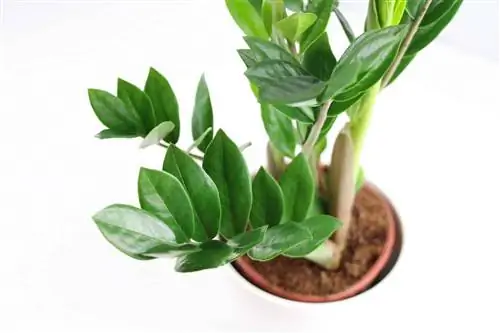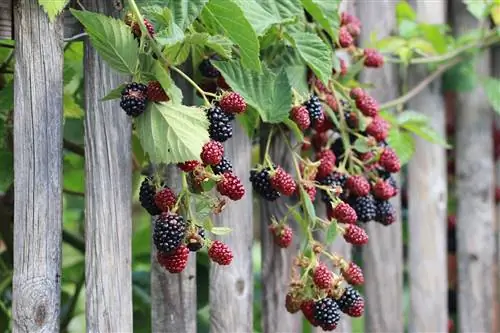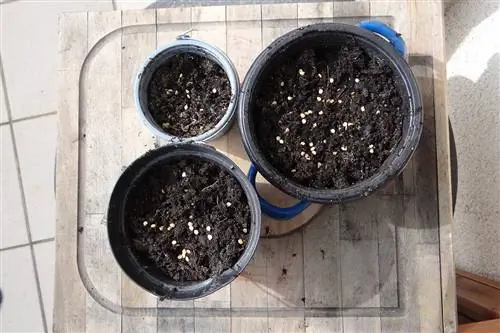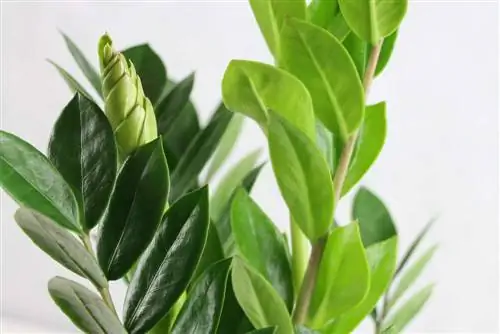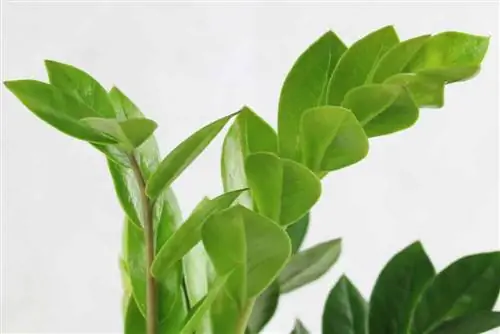- Author admin [email protected].
- Public 2023-12-17 03:39.
- Last modified 2025-01-24 12:45.
A zamioculcas forms horizontal, tuberous runners (rhizomes) in the soil. From each of these small tubers only a single, pinnate leaf with five to eight pairs of leaflets grows. These have a juicy stem that thickens towards the bottom and rich green, shiny leaves.
It takes a number of care mistakes to put a strain on this plant's strong will to survive. That's why it's also well suited for people who don't have a green thumb.
Profile
- Botanical name: Zamioculcas zamiifolia
- other names: Zamie, cardboard paper palm or lucky feather
- belongs to the arum family
- Growth height: 40-90 cm, sometimes over a meter
- Decorative leaf plant, houseplant
- Leaves: pinnate, thick, fleshy stem with individual leaves
- Flower: inconspicuous cob with light green bract
- not frost hardy
Location
Zamioculcas zamiifolia is very frugal when it comes to choosing its location. It also gets along with little light and grows even in slightly shady areas of the room. However, the lucky feather prefers to be placed in a bright room without direct sunlight. The brighter the location, the faster the plant grows and the brighter its leaves become. If it is relatively dark, it grows more slowly, but the leaves are a strong, lush green.
- Light requirements: sunny to partially shaded (no midday sun)
- Temperature: between 18 and 25 °C
- Soil: well-drained, humus-rich substrate
- In summer also in a partially shaded spot outdoors
Floor
The lucky feather is not picky when it comes to substrate. A good universal potting soil or palm soil can be used. A mixture of is also favorable
- Garden soil
- finely crumbly, ripe compost
- coarse sand
- Peat
Tip:
The Zamie is ideal for an office. It can survive a holiday period of three weeks without any damage if there is no one to water it.
Pouring
Zamiokulkas has succulent properties because it is able to store water in all parts of the plant in order to survive longer dry periods. Nevertheless, the lucky feather likes its substrate to be kept slightly moist at all times. If there is a period of drought lasting weeks, the leaf is initially deprived of sap to such an extent that individual pairs of feathers die off. As it progresses, a predetermined breaking point forms about 10-15 cm above the tuber, where the leaf breaks off in order to protect the stump from dying. The plant is considered to be extremely robust; even people without a green thumb who tend to forget to water can enjoy the beautiful, juicy green leaves of the plant for a long time. The plant cannot tolerate waterlogging.
Tip:
It is better to keep the zamioculcas a little too dry than too wet.
Fertilize
Zamioculcas zamiifolia is the only member of the genus Zamioculcas within the arum family and originally comes from East Africa, where it occurs, for example, in the forests of Kenya and South Africa. A lucky feather has a relatively low nutrient requirement. Therefore, fertilizer application is only necessary at long intervals. From April onwards, you can fertilize with a universal liquid fertilizer for green plants via irrigation water approximately every 5-8 weeks. Alternatively, fertilizer sticks can also be used. The last fertilizer application takes place in August or early September.
Propagate by division
Larger plants can easily be divided when repotting in spring. To do this, the Zamioculcas zamiifolia is carefully pulled out of the pot. Make sure to grab the shoots as far down as possible when pulling them out, as the juicy leaves tend to break off.
- Shake the substrate out carefully
- leave at least three leaflets together
- Pulling rhizomes apart
- Cut connections with a sharp knife
- insert into relatively small pots with fresh substrate
- Depth as before
- Press down the soil and water lightly
Propagation by cuttings
In contrast to most cuttings, which are grown from fresh shoots of a plant, with Zamioculcas zamiifolia it is possible to grow a complete plant from just a single leaflet of a leaf. However, propagation through so-called leaf cuttings is a very time-consuming process that can take a few months. But it is very simple and in most cases very successful. In principle, the leaf cuttings can simply be placed in a container with moist soil or a darkened glass with water. However, since the soil tends to grow mold, the following method is recommended:
- Time: Spring
- cut off several lower leaflets close to the base
- Cut a household sponge into small cubes
- Size: about 3 x 3 cm
- score a notch on the top with a sharp knife
- Depth about 1 cm
- insert a leaf cutting into each
- put on coaster
- fill with water
- place bright and warm (22 °C, without direct sun)
- keep evenly moist
After a few weeks, a thickening forms at the base of the leaf. New roots slowly grow out of this tuber over the following days and weeks. If the cutting is finally sufficiently rooted, a completely new shoot emerges from the tuber and the former leaf dies. Now the young plant can be placed in fresh soil and watered and fertilized normally. However, it will take around six to nine months until then.
Repotting
Only when the existing pot is well-grown with rhizomes and roots does the Zamiokulkas need a larger pot and some fresh soil. As a rule, this only happens every two to three years. If the plant is bright, it grows faster and needs to be repotted more often. If the lucky feathers are placed darker, it is sometimes only necessary to put the plant in a slightly larger pot every 4-5 years. Regardless of growth and pot size, the plant should always be given some fresh soil at least every two years when watered with normal tap water. Drinking water contains lime, which accumulates in the soil and leads to unfavorable soil conditions.
- Time: Spring
- choose just a little larger pot
- possible time for a division
- Pull the plant out of the pot very carefully
- shake out or knock off old soil
- Leaves break off easily
- Fill drainage layer into new planter (approx. 3 cm)
- fill in some fresh substrate
- Insert plant
- carefully fill in fresh substrate
- Keep placing the pot firmly on the surface
- so the earth sags and cavities are avoided
- Press the soil lightly
- pour on
Overwintering / resting phase
Overwintering in the actual sense is not necessary for the evergreen Zamioculcas zamiifolia. However, it is good for the plant if it is kept a little cooler in the winter months and is watered less. However, the substrate must never dry out during this resting period, because then the lucky feather drops its leaves. The tropical plant cannot tolerate cold drafts or temperatures below 16 °C. From April you can water and fertilize more again.
Diseases and pests
Pests are very rarely found with the Zamioculcas zamiifolia. Occasionally, when the heating air is very dry, an infestation with spider mites or red spiders occurs. If the lower leaves of the plant turn yellow, this indicates waterlogging. If the roots rot, the entire plant can die. In this case, the old soil should be removed immediately, any rotten roots cut off and placed in fresh substrate.
Conclusion of the editors
Even people who don't have a green thumb at all can use the Zamioculcas zamiifolia to beautify their home or office with a lush green plant. It is extremely robust and easy to care for. There are only two things it can't tolerate: waterlogging and the midday sun. Otherwise you can hardly go wrong with the Glücksfeder.
What you should know about Zamiokulkas in brief
Location
- Zamiokulkas likes a bright location, but no direct sunlight, at least no midday sun.
- The brighter the location, the faster the plants grow and the lighter the leaves are.
- If the plant is darker, it grows a little slower, but the leaves become a beautiful dark green.
- In summer it can be placed anywhere in the room, in winter you can put it close to the window.
Planting substrate
- The planting substrate must be well-drained. It is beneficial if it contains mineral components.
- Commercial cactus soil mixed with clay granules turned out to be good.
- With normal potting soil you have to be careful when watering, because it stores water for a long time.
- In any case, a drainage layer at the bottom of the pot is recommended.
- Before repotting, wait until the plant pushes itself out of the pot or bursts the pot. It forms very strong roots.
Watering and fertilizing
- It's best to keep the plant evenly and slightly moist. In winter you should water a little less.
- In spring the plant gets going again and grows new leaves.
- You can also keep the Zamiokulkas zamiifolia quite dry overall and hardly water them at all in winter. Then the plant dries back.
- In the worst case, only the thickened petioles remain.
- The plant sprouts reliably when watered again in spring.
- The Zamiokulkas is quite indestructible. She just doesn't like standing water, i.e. wet feet.
- Fertilization is done every three months with fertilizer sticks.
Wintering
- The plant should be bright. Temperatures around 15 °C are sufficient.
- You can also overwinter the Zamiokulkas in the warm living room.
- She really likes being sprayed with water every now and then.
- There is less watering than in the other months. There is no fertilization.
Propagation
- The easiest way to propagate the Zamioculcas is by division. The plant grows quickly and spreads.
- It can be easily divided when repotting.
- You can also propagate them through leaf cuttings, but this takes a very long time.
Diseases and pests
- Zamiokulkas zamiifolia appears to be resistant to pests and diseases.
- The only thing that can kill this plant is permanently wet roots, otherwise it is absolutely tough.

